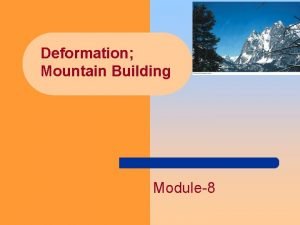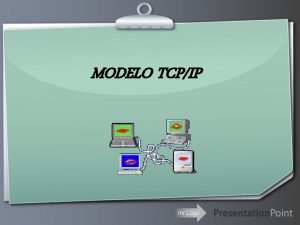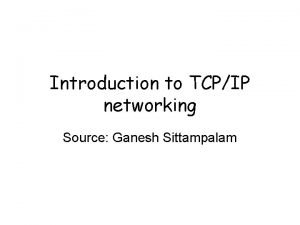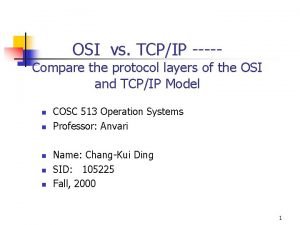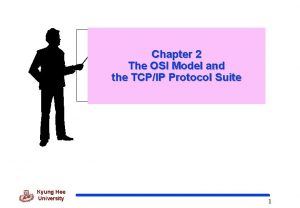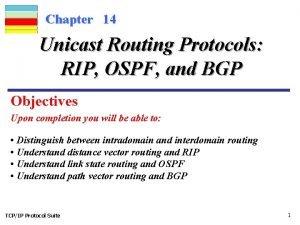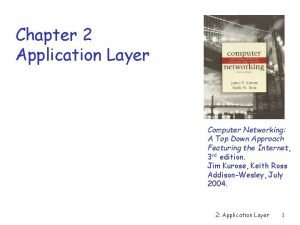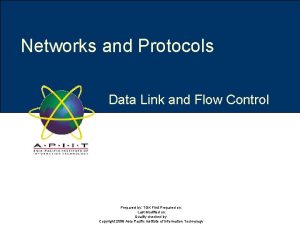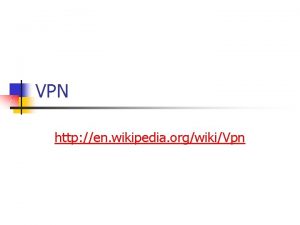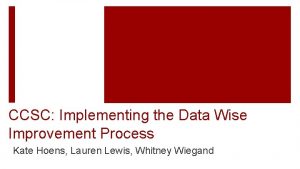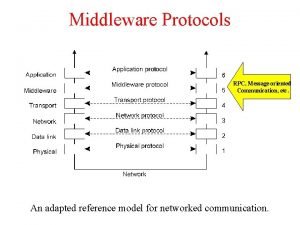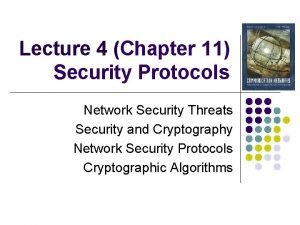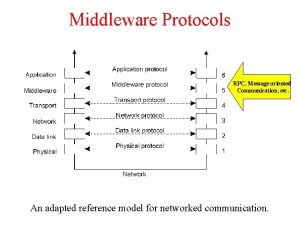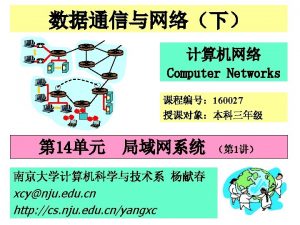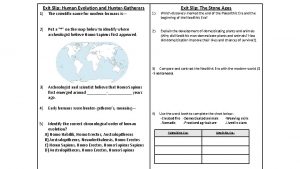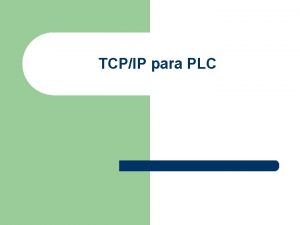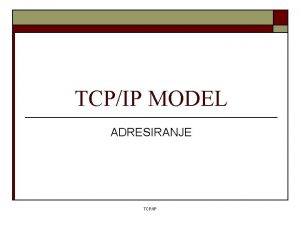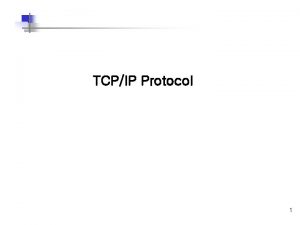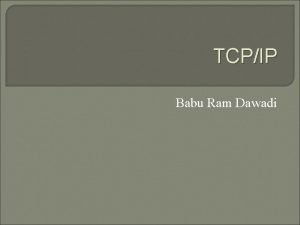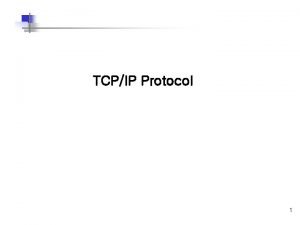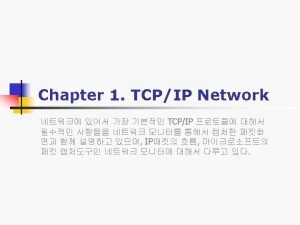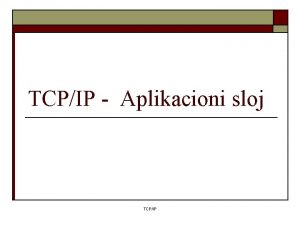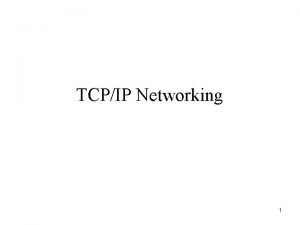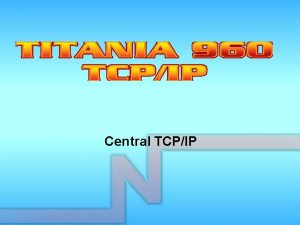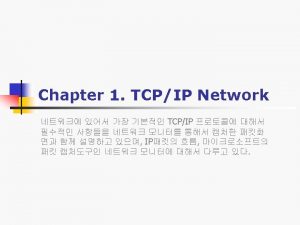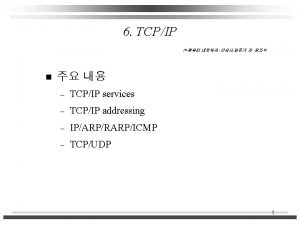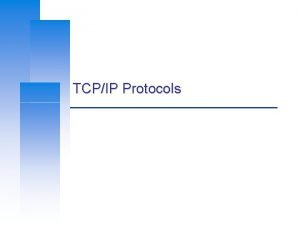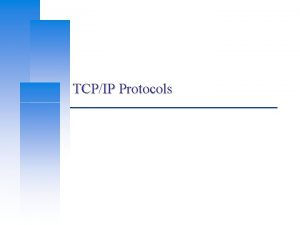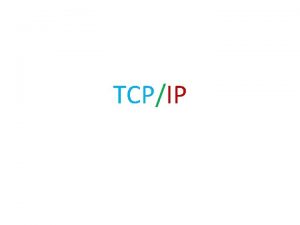5 TCPIP Fundamentals 5 1 TCPIP Protocols SLIP























- Slides: 23

5. TCP/IP Fundamentals: 5. 1 TCP/IP Protocols - SLIP and PPP; ARP; ICMP; TCP and UDP. 5. 2 IP Addressing - IP Address Assignments; IP Address Classes; Subnet Masking; Registered and unregistered Addresses.

TCP/IP PROTOCOL SUITE : The TCPIIP protocol suite was developed prior to the OSI model. Therefore, the layers in the TCP/IP protocol suite do not exactly match those in the OSI model. The original TCP/IP protocol suite was defined as having four layers: host-to-network, internet, transport, and application. However, when TCP/IP is compared to OSI, we can say that the host-to-network layer is equivalent to the combination of the physical and data link layers.

TCP/IP PROTOCOL SUITE : The internet layer is equivalent to the network layer, and the application layer is roughly doing the job of the session, presentation, and application layers with the transport layer in TCPIIP taking care of part of the duties of the session layer.

ISO/OSI Network Model (Don’t need to know this) Seven network “layers” Layer 1 : Physical – cables Layer 2 : Data Link – ethernet Layer 3 : Network – IP Layer 4 : Transport – TCP/UDP Layer 5 : Session Layer 6 : Presentation Layer 7 : Application You don’t need to know the layers just the idea that it is layered

TCP/IP Network Model Different view – 4 layers Layer 1 : Link (we did not look at details) Layer 2 : Network Layer 3 : Transport Layer 4 : Application

OSI: Open Systems Interconnect OSI and Protocol Stack OSI Model TCP/IP Hierarchy Protocols 7 th Application Layer 6 th Presentation Layer Application Layer 5 th Session Layer 4 th Transport Layer 3 rd Network Layer 2 nd Link Layer 1 st Physical Layer Link Layer Network Layer Transport Layer Application Layer Link Layer : includes device driver and network interface card : handles the movement of packets, i. e. Routing : provides a reliable flow of data between two hosts : handles the details of the particular application

IP Responsible for end to end transmission Sends data in individual packets Maximum size of packet is determined by the networks Fragmented if too large Unreliable Packets might be lost, corrupted, duplicated, delivered out of order

IP addresses 4 bytes e. g. 163. 1. 125. 98 Each device normally gets one (or more) In theory there about 4 billion available But…

Routing How does a device know where to send a packet? All devices need to know what IP addresses are on directly attached networks If the destination is on a local network, send it directly there

Routing (cont) If the destination address isn’t local Most non-router devices just send everything to a single local router Routers need to know which network corresponds to each possible IP address

IP packets Source and destination addresses Protocol number 1 = ICMP, 6 = TCP, 17 = UDP

IP Datagram 0 4 8 Vers Len 16 TOS 24 31 Total Length Identification TTL 19 Flags Protocol Fragment Offset Header Checksum Source Internet Address Destination Internet Address Options. . . Padding Data. . . Field Vers Len TOS T. Length Ident. Flags Frag Off Purpose IP version number Length of IP header (4 octet units) Type of Service Length of entire datagram (octets) IP datagram ID (for frag/reassembly) Don’t/More fragments Fragment Offset Field TTL Protocol Purpose Time To Live - Max # of hops Higher level protocol (1=ICMP, 6=TCP, 17=UDP) Checksum for the IP header Source IA Originator’s Internet Address Dest. IA Final Destination Internet Address Options Source route, time stamp, etc. Data. . . Higher level protocol data We only looked at the IP addresses, TTL and protocol #

IP Routing Source Destination Application Transport Router Transport Network Link Routing Table Destination IP address of a next-hop router Flags Network interface specification

UDP Thin layer on top of IP Adds packet length + checksum Guard against corrupted packets Also source and destination ports Ports are used to associate a packet with a specific application at each end Still unreliable: Duplication, loss, out-of-orderness possible

UDP datagram 0 16 31 Source Port Destination Port Length Checksum Application data Field Source Port Destination Port Length Checksum Purpose 16 -bit port number identifying originating application 16 -bit port number identifying destination application Length of UDP datagram (UDP header + data) Checksum of IP pseudo header, UDP header, and data

Typical applications of UDP Where packet loss etc is better handled by the application than the network stack Where the overhead of setting up a connection isn’t wanted VOIP NFS – Network File System Most games

TCP Reliable, full-duplex, connection-oriented, stream delivery Interface presented to the application doesn’t require data in individual packets Data is guaranteed to arrive, and in the correct order without duplications Or the connection will be dropped Imposes significant overheads

Applications of TCP Most things! HTTP, FTP, … Saves the application a lot of work, so used unless there’s a good reason not to

TCP implementation Connections are established using a three-way handshake Data is divided up into packets by the operating system Packets are numbered, and received packets are acknowledged Connections are explicitly closed (or may abnormally terminate)

TCP Packets Source + destination ports Sequence number (used to order packets) Acknowledgement number (used to verify packets are received)

TCP Segment 0 4 10 16 Source Port 19 24 31 Destination Port Sequence Number Acknowledgment Number Len Reserved Flags Window Checksum Urgent Pointer Options. . . Padding Data. . . Field Source Port Destination Port Sequence Number Acknowledgment # Len Flags Window Checksum Urgent Pointer Options Purpose Identifies originating application Identifies destination application Sequence number of first octet in the segment Sequence number of the next expected octet (if ACK flag set) Length of TCP header in 4 octet units TCP flags: SYN, FIN, RST, PSH, ACK, URG Number of octets from ACK that sender will accept Checksum of IP pseudo-header + TCP header + data Pointer to end of “urgent data” Special TCP options such as MSS and Window Scale You just need to know port numbers, seq and ack are added

TCP : Data transfer Client Timer Send Packet 1 Start Timer ACK would normally Arrive at this time Host Packet Lost Packet should arrive ACK should be sent Time Expires Timer Retransmit Packet 1 Start Timer Receive ACK 1 Cancel Timer Receive Packet 1 Send AXK 1

Thank You…………
 Elysium mons
Elysium mons Thrust fault
Thrust fault Dip slip vs strike slip
Dip slip vs strike slip Tcpip
Tcpip Tcpip logo
Tcpip logo Modelo tcpip
Modelo tcpip Osi tcpip
Osi tcpip Tcpip vs osi
Tcpip vs osi Ois 7계층
Ois 7계층 History of osi model
History of osi model Arquitetura tcp-ip
Arquitetura tcp-ip Write a detailed note on unicast routing protocols
Write a detailed note on unicast routing protocols Application layer protocols
Application layer protocols Gateway protocols
Gateway protocols Flow control protocols
Flow control protocols Friendship group definition
Friendship group definition Gfta bell curve
Gfta bell curve Vpn protocols wiki
Vpn protocols wiki Data wise protocols
Data wise protocols What are two pitfalls (problems) of lock-based protocols
What are two pitfalls (problems) of lock-based protocols Receipt-based transient synchronous communication
Receipt-based transient synchronous communication Playfair cipher
Playfair cipher Asynchronous rpc
Asynchronous rpc 802 protocols
802 protocols


